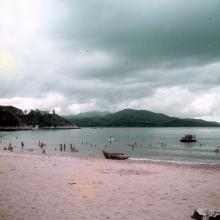Wells in Hong Kong
Primary tabs
eurasian_david found this report of a well at 4 Queen's Road Central being closed in 1899:
“A WELL TO BE CLOSED.
Mr. F. Browne, Government Analyst, certified that the water obtained from a well at No. 4 Queen’s Road Central was so tainted with impurities as to be unfit for potable purposes and likely to prove injurious to health.”
Source: The Hong Kong Weekly Press, page 459, 2nd December 1899
I think I've read of one of the big banks in Central using its well for water during the fighting in 1941. There's also a 24 Dec 1941 diary entry from Henry Ching talking about wells where he lived in Happy Valley:
We had to do something about water. Among its preparations, the Government had made ready concrete slabs to be fitted into the nullahs which perpetually carry mountain spring water to the sea, thus to form little local reservoirs. One deep nullah runs past our front door. The slabs are there, but no one put them in position. The water anyway is not usable. The nullah is carpeted with garbage, and on this now rests a corpse. We explored our own flush water well, but oil from the pump had fouled it badly. Our neighbour was more fortunate; the water in his well was clear and sweet, and we drew from there.
The Hilton Hotel was using its own well for water during the 1963 rationing (see https://gwulo.com/atom/30352), though they don't say if the well was on the hotel site, or elsewhere.


rural wells
The 1897 Public Works Report mentions wells in the rural parts of Hong Kong: (under the heading 'Future public works') "Something should be done towards providing a pure water supply for villages outside the system in Hongkong and Kowloon. This can be done by sinking new wells at some distance from the dwellings, and lining them with concrete or masonry in cement for a certain depth, and then closing the existing wells which are usually close to the houses or pig-sties, unlined and receiving all the surface washings and sewage."
Yau Ma Tei wells
The 1893 Public Works Report refers (at 44) to pipes being laid to carry water "from the wells in the valleys to the pumping station at Yaumati" and states that "the roads leading to the wells have been partially formed, the reclamation at Yaumati, including the training of the nullah, to form the site of the pumping station and clear-water reservoir is in progress and the elevated reservoirs into which the water is to be pumped are being constructed."
The 1895 Public Works Report also refers to wells near the village of Yau Ma Tei:
"100. The sources of supply are three valleys situated north of the village of Yaumati. In these, wells have been sunk, and puddle dams constructed across their outlets to prevent the escape of subsoil waters.
101. In the valleys exists a considerable depth of sandy deposit washed down from the hills, in this are laid open jointed pipes conducting the water to the wells.
From the wells the water is conveyed by cast iron inverted syphons laid along the roads constructed in connection with this project to the clear water tank at Yaumati from which it is pumped to the reservoir on the hill north of the Rifle Range and through the distributing mains to the reservoir at Hung Hom."